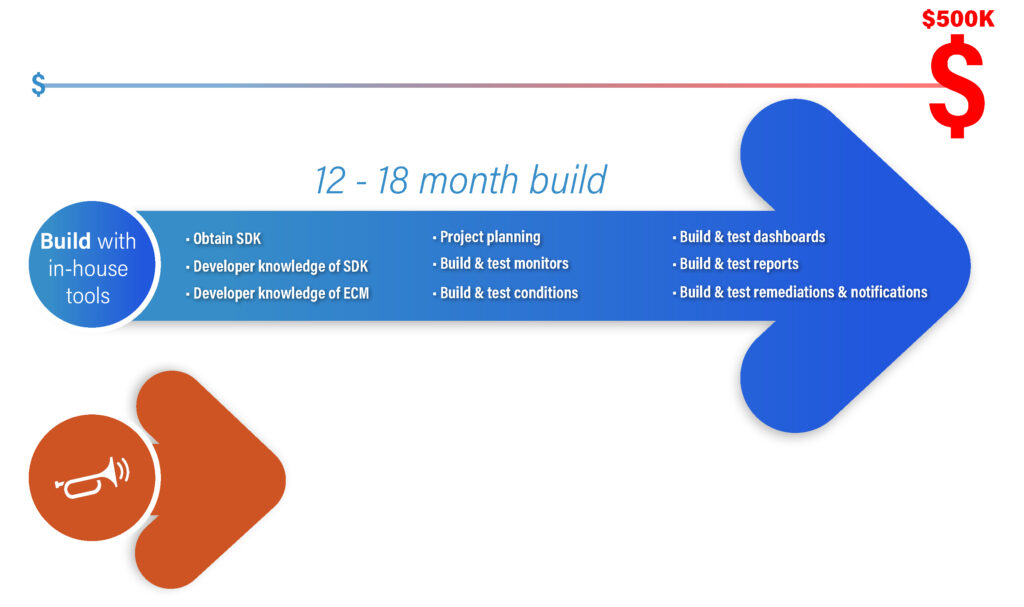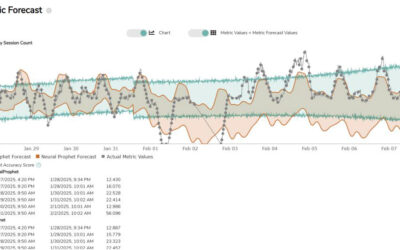The costs of an Enterprise Content Management (ECM) system monitoring vary by a huge degree. While some companies opt to build their systems themselves, others opt for purpose-built monitoring. Depending on whether you choose to buy or build your ECM system monitoring, you may experience huge costs and long adoption periods or a solution that is cost-effective and easy to adopt.
In this guide, we’ll explore the four key areas affecting costs and risks and whether you should buy or build your ECM monitoring solution.
Table of Contents
- What is ECM Monitoring In-House?
- Four Key Areas Affecting Costs and Risks of In-House ECM Monitoring
- Why Buy vs. Build
- Take the Next Step in ECM Monitoring Excellence
What is an ECM Monitoring In-House?
Managing a full Enterprise Content Management (ECM) application stack often relies on a comprehensive monitoring system to ensure the smooth operation of business-critical processes and workflows dependent upon ECM services.
The question is, how will this environment be continuously observed and managed, and how will ECM provide context-sensitive information for IT and business management? One option for organizations is to build their own effective ECM monitors in-house.
It is essential to examine the associated costs before making an educated decision. It is very likely that your organization employs common application management and infrastructure management tools offered by the likes of Splunk, NewRelic, Dynatrace, Solarwinds, Nagios, Zappo, etc. These monitoring tools are vital for modern-day enterprises and serve key areas such as server management, network management, cloud services, etc. However, when it comes to enterprise content management, your IT operations will be challenged when developing and maintaining truly effective monitors offering deep visibility and context.
Let’s dive into the specifics to understand the total cost and risk impact of building in-house ECM monitoring capability as opposed to buying a purpose-built solution.
Four Key Areas Affecting Costs and Risks of In-House ECM Monitoring
Instead of making a decision solely based on the available solutions and their costs, here are four key areas you should consider that go beyond the price tag.
1. Development Knowledge Gap and Costs
Building ECM monitors from scratch requires significant investment in development resources. You need skilled developers who understand ECM system architecture and can design and implement monitoring functionalities. This involves salaries, benefits, recruitment expenses, and the necessary hardware and software infrastructure.
And it’s not only developing the software but also the staff to produce and maintain such monitors appropriately. It requires a team with specialized knowledge of ECM systems and monitoring best practices. Organizations must invest in training programs to keep their IT staff updated with ECM platform technologies, monitoring techniques, and emerging industry trends.
2) Development Time and Effort
Depending on the complexity and scale of the monitoring system, the development timeline can range from several months to over a year. Consider the image below and the requirements for building an effective monitoring system for ECM:
A. Acquisition of necessary tools
- Obtain Software Development Kit(s) (SDK) for each ECM platform
- Develop or obtain developer knowledge of SDK(s) for each ECM platform
B. Planning and knowledge development
- Develop a detailed project plan outlining each phase of the development process.
- Gain or improve developer-level understanding of the ECM platform stack, including its interfaces and operational behavior.
C. Project management and team coordination
- Assign a Project Manager to oversee the development lifecycle and ensure milestones are met.
D. Design and development phase
- Design, build, and perform Quality Assurance (QA) on various components, including:
- Tests to validate functionality.
- Monitors for tracking system performance.
- Conditions/Thresholds to set operational benchmarks.
- User-friendly Displays and Dashboards for real-time monitoring.
- Comprehensive Reports for analysis and decision-making.
- Remediations/Automations for proactive system management.
- Notifications to keep relevant stakeholders informed.
E. Implementation and integration
- Seamlessly integrate the developed system into the existing ECM environment.
- Move through a DevOps process to transition the system to a production state, ensuring continuous integration and deployment.

3) Ongoing Maintenance and Updates
As seen in the image above, once the ECM monitors are deployed, ongoing maintenance and updates are crucial to keep them effective and aligned with changing ECM systems or organizational requirements. This entails assigning resources to monitor the monitors, fix issues, and introduce enhancements. Over time, these maintenance efforts can accumulate, straining IT budgets and diverting personnel from core business activities. As the ECM applications are updated with new feature capabilities, API interfaces, and expanded platform support (such as OS, databases, and application services), the ECM monitoring needs to maintain pace, or your monitoring blind spots will reappear.
4) Scalability and Risk Challenges
As organizations grow and their ECM needs to evolve to support digital transformation initiatives, scalability and adaptability become vital considerations. In-house ECM monitors may lack the flexibility required to adapt to changing circumstances, such as adding support for intelligent automation technologies like RPA.
Scaling a custom monitoring solution necessitates substantial modifications, which can be complex and costly. Adding new features, integrating with other systems, or accommodating increased user demands can require additional development efforts and resources. Taking these pieces together, the development cost, time to deploy, ongoing maintenance, and architecture flexibility increase the risk profile of the custom ECM monitoring solution compared to a proven ‘off the shelf’ solution.
Why Buy vs. Build
While building in-house monitoring capability offers organizational control, there are many costs and risks to consider, like development costs, time and effort, maintenance, risk, and scalability. These costs can occur at the onset and over a multi-year period. Taking that into consideration, having effective in-house monitoring for ECM is no small challenge.
This is why some of the largest organizations in the world, with a multitude of IT skills, capabilities, and budgets, choose Reveille to monitor their ECM applications. As some of the common, well-known infrastructure and application management monitoring companies are built for wide use cases, Reveille fills the ECM monitoring gap to complement the existing tools in your IT management toolset. Try Reveille’s value calculator to understand your current ECM monitoring/issue costs vs. using a purpose-built tool like Reveille.
Take the Next Step in ECM Monitoring Excellence
Getting access to an ECM monitoring tool like Reveille can help you streamline your monitoring process and reduce manual intervention. You can schedule a range of pre-built tests and automate resolutions to common problems.
Instead of waiting for months to build a perfect solution, contact Reveille and schedule a demo to understand how our system works and what it can do for your organization.





